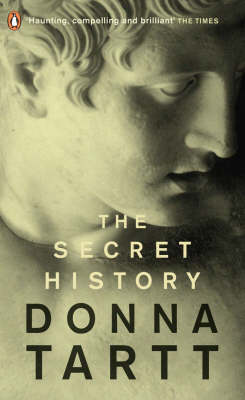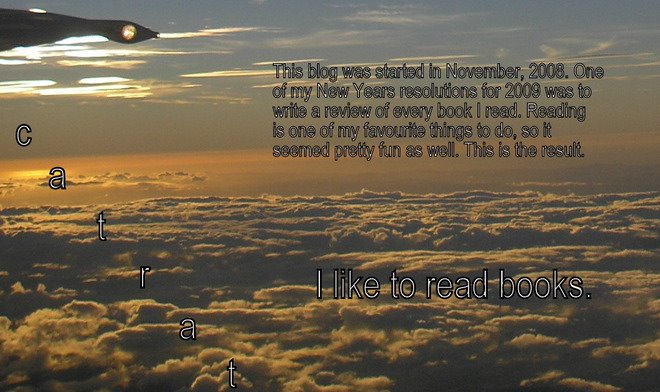skip to main |
skip to sidebar

I enjoyed this book far more than others I have read by Atkinson. It tells the story of Ruby Lennox, starting off as a young girl whose state of affairs has been created by generations of her family. The book switches between Ruby's life and her understanding of it back to her mother's and grandmother's generations and how they have impacted on the existence Ruby is offered. There is a lot to be seen from the way the lives of these women are constructed around typical gender roles, while Alice, Ruby's grandmother spent her days cleaning, mending, taking care of the children and housekeeping whily Bunty, Ruby's mother spends her days doing what can only be seen as a mask for what her mother did, which in a different era becomes a conception of nothing. The parts of the book that go into Ruby's genealogy and how her grandmother and mother came to be the women they are is detailed in "footnotes."
We watch Ruby grow into a young woman throughout the book. Seeing the perceived mistakes of her sister who she goes for years without seeing, she constructs an understanding about the world from her experiences as well as the experiences of her maternal family, where it seems male figures have been markedly absent. The book is a reversal of the age-old genealogy through patriarchy as Ruby discovers and understand the world primarily and distinctly through females.
This book is written amazingly, the language is beautifully done and the plot is effectively woven through genealogical history. I far preferred it to two other books I have read by the author and I think this work is a masterpiece.
No adequate book image sorry.

This autobiography documents the amazing life of Sonja Davies; a prominent New Zealand feminist, trade unionist, member of the peace movement and MP for the Labour Party in the late-1980s to the early-1990s. Davies shares with amazing insight her early life, born as an illegitimate child in 1920s New Zealand brought up by her grandparents in Oamaru. The chapter is entitled "A different childhood" and this conceptualises her life very well. Later on, living with her mother and life as a child in New Zealand at this time is most accurately represented. The book continues as Davies left shcool early to enter the workforce, went to nurses school and eventually became a vital part of the movement for trade unions in New Zealand. Amidst all of this, she marries at 17, before falling in love with an American marine, later killed in the Pacific part of World War II. Giving birth to her first child, she becomes very sick and this begins her years-long battle with tuberculosis. Despite this, this amazing woman came through all of this, married and continued her amazing work as an activist in New Zealand Labour Federations, child care centres and her first political contests.
There is no doubting that Davies had a difficult life, from the very beginning she was different, a 'love child' with a colourful family life. It is made clear here that this woman who thinks she was just one of many was a hero in many ways and definitely a huge figure. This book covers her life up until the 1980s and how she dealt with the many challenges life threw at her. There is nothing innately astonishing about Davies' writing, but it is her firm honesty and compassion to the cause which catches the reader. Her relationships with a wide variety of prominent New Zealand names including Norman Kirk (former NZ Prime Minister), Walter Nash (former NZ Prime Minister), Mary Varnham (former Labour Press Secretary for David Lange) and Sue Kedgley (current Green Party MP). The latter two co-editors of another book I have reviewed which Sonja Davies also had a chapter in. It is also clear that Davies had a deep connection with her environment, living all over New Zealand at various times in her life and appreciating the sights it has to offer.
The one downside I would suggest this book has is its confusing timeline. The subtitles suggest the book is written chronologically, but at many times different things happening at similar times are in different chapters. I can obviously understand why she would want to separate aspects such as her son Mark's tragic death but this did confuse me as a reader and I think it would have represented the many things this amazing woman did even more if they had all been included in the same chunk. A further review of her second book Marching On... will come later.
Overall an amazing read (apparently also made into a movie) documenting the life of one of New Zealand's forthright figures in trade unionism. I would highly recommend it to any New Zealander, regardless of their political stance. It is a highly historical account of New Zealand and growing up in New Zealand.
Sonja Davies died in 2005.

This is an excellent book on the physiology of the female body. Angier, a well known science writer exposes the world of biology; each chapter explores a different part of the female body from its Darwinian origins to its purpose to some "mutations" as it were of that particular part of the body. Angier's witty voice and stunning prose keeps the reader interested throughout the book.
The book concentrates on how biology (along with many other subjects) looks at the male body as the norm rather than a more gendered look at both male and female biology. While many have dismissed the book as a feminist tirade, the clear transmission of science and the stunning way in which the body is presented makes this read well worthwhile. Angier dispels several common stereotypes about the female body and fully explains the reasons for these stereotypes and the reality. There are also some fascinating case studies of more unusual women and the way they have dealt with the difference in their bodies from other women.
Angier also displays some intelligent writing on the various myths coming out about differences between females and male, she attacks evolutionary psychology primarily for its view of women as monogamous and men as polygamous.
This is the best non-fiction book I have read in awhile and I would highly recommend it to females and males alike.

I thoroughly enjoyed this book, possibly the best fiction book I've ever read. Possibly, as I can't think of them all right now, but it definitely rates near the top. The way Tartt manages to weave together so many different themes and still make this book a highly enjoyable read speaks volumes about her talent as a writer.
The story is told by Richard, arriving at Hampden College; a rich upper class university in New England. Richard arrives at this school hoping to be accepted into Greek which he had already begun to learn. What transpires is the Greek professor, Julian Morrow, convincing him to drop all of his other courses (except French) and give himself fully over to the Classics. Richard finds himself in the midst of a sort of clique of strange, mildly friendly Greek-studying students. All of the students have strong characters built up by Tartt throughout the book. I won't try to describe them now, except to say that they all serve a part in this exceptional thriller or tale of misguided rich kids.
Richard finds himself invited into the group and is confused and fascinated by the students everyone else regards as slightly strange. He soon realises though that something is wrong. Thus, the plot thickens.
The story is extraordinarily told, drawing on Greek tragedy enveloped with Ancient Greek practices as well as drinking, jealousy and pressure. Tartt beckons the reader into the seemingly complex cycle of events and you are led not so much by what she says but what she suggests.
I would highly recommend this book to anyone.

According to Amazon, this astonishing book was originally written as Millett's doctoral thesis in 1968 and is now widely regarded as a feminist classic. The book looks at American literature including works by D.H. Lawrence, Henry Miller, Norman Mailer, John Stewart Mill and Jean Genet. Millett examines in depth the structures and values in the literature and the passages she quotes from each text are truly telling of the argument she puts across. The critique and analysis she provides is amazing and its in-depth look at the politics of sex is supported by the provided literature. While the reader can be stunned at these analyses, we can also see hope in the incredibly telling writings of Jean Genet.
I thoroughly enjoyed this book, it wasn't the easiest read in the world and more or less put me off at least Henry Miller's books for a good while, but at the same time it was incredibly thought-provoking of an area that has largely been overlooked as influencing public opinion of gender relations and sex.
The book also provided an interesting look at gender relations under the law of coverture in the Western world with excerpts from Blackstone's Commentaries - the foremost legal writings of the time included. It also took a look at sexual politics in Nazi Germany and Soviet Russia among others. This part of the book was so interesting I almost changed the topic of an essay plan in fascination over it. But I will leave the eager reader to devour its brilliant contents.
As well as this, there was an entire chapter on Freud, psychoanalysis and general beliefs about women's psychology. The social pretension of the concept of "penis envy" is displayed in what is remarkable from a book of the time, when these beliefs about psychology were still so prevalent.
A stellar read I would recommend to anyone and everyone.

This romantic fiction book offers a unique take on the concept of time travel. The book follows Henry as he travels through time and appears, disappears and reappears in Clare's life. His age is ever-changing throughout the book and Clare is forever skirting around what is his past, his future and his present. The reader is left like Clare, wondering where in Henry's life we are entering every time he reappears.
This extremely popular book was all a little too perfect for my tastes. Romantic, perfect and with an interesting twist and a purely confusing chronology; it entices the reader in. Despite all this, the character development leaves a little to be desired. The book also develops very well though, despite the fact we are taken from year to year, from seeing Clare as a young child to a grown woman. The whole concept of waiting for a man for that long sort of annoyed me, especially because Clare never seemed to question her own state of affairs. We also never hear enough about Henry's past, although we definitely know it is troubled. One would imagine that disappearing at random intervals only to appear unexpectedly again would create difficulties to say the least.
So it was mainly the plot and the design of the various intervals that seemed too "perfect" to me and because of the lack of character development inherent in the plot, it was also too easy to believe. A good book overall but it didn't ring true in my mind.






